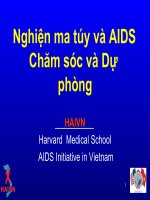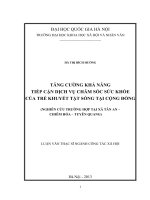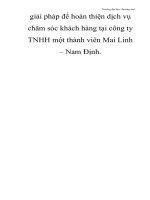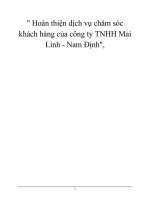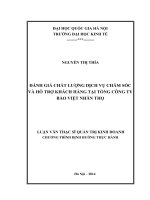Cải thiện dịch vụ chăm sóc và dự phòng HIV cho những người tình dục đồng giới nam_Improving HIV Prevention and Care Services for MSM in Cambodia: The SAHACOM
Bạn đang xem bản rút gọn của tài liệu. Xem và tải ngay bản đầy đủ của tài liệu tại đây (600.81 KB, 26 trang )
Improving HIV Prevention and Care Services for MSM in Cambodia: The
SAHACOM
Siyan Yi, MD, MHSc, PhD
Director, Center for Population Health Research, KHANA
Adjunct Ass. Professor, Center for Global Health Research, Touro University California
Co-Investigators:
Pheak Chhoun, Kouland Thin, Carinne Brody
Khimuy Tith, Sovannary Tuot
th
7 ICPH, Hue City, Vietnam | 26-27 September 2015
1
Global HIV Situation among MSM
– Challenges in HIV programs: Greater risk for HIV, less access to intervention programs, and
less understood due to their more hidden and stigmatized nature (Altman et al., 2012
– HIV prevalence:
•
3.0% in the Middle East and North Africa region to as high as 25.4% in the Caribbean (Beyrer et
al., 2012)
•
HIV and STI prevalence continues to rise (Beyrer et al., 2013)
– Condom use and HIV testing: Considerably low in low- and middle-income countries (Oldenburg et
al., 2014)
2
Global HIV prevalence in MSM, from studies published 2007–2011 (Beyrer et al., 2012)
3
Global prevalence of HIV in MSM compared with regional adult prevalence (UNAIDS, 2010)
4
Map of the Study Sites
5
Estimations and Projections of HIV Prevalence among General Population
Aged 15-49 (1990-2015)
8/6/18
6
HIV Situation among MSM in Cambodia
– HIV/STI prevalence:
•
•
•
2010: 2.2% (BROS Khmer Study, 2010)
2015: 2.4% (NCHADS, 2015)
STI symptoms in the past 12 months: 51.5%
– HIV risk behaviors (past 3 months):
•
•
•
•
•
•
(Yi et al., 2015)
Mean number of sex partners: 4
Had sex with a girlfriend: 32.2%
Had sex with FSWs: 14.6%
Had sex with MSWs: 9.9%
Sold sex to women: 8.9%
Sold sex to men: 17.4%
7
Condom Use among MSM in Cambodia
– Always used condoms (past 3 months):
•
•
•
•
•
•
Girlfriends: 55.1%
Boyfriends: 64.2%
Female sex workers: 75.9%
Male sex workers: 73.0%
Female clients: 78.1%
Male clients: 70.3%
– Always used lubricant (past 3 months):
•
•
(Yi et al., 2015)
(Siyan Yi et al. 2015)
Anal sex with boyfriends (80.8%)
Selling anal sex (64.1%)
8
Factors Associated Inconsistent Condom Use among MSM in Cambodia
• Older age: ≥25
• Self-perception of higher HIV risk compared to the general population (Higher:
36%, Same: 16.4%, Lower: 46.6%)
• Illicit drug use
• Reported consistent lubricant use when having anal sex with men
• Self-reported quality of life as good or very good
(Yi et al., 2015)
9
HIV Testing among MSM in Cambodia
– HIV testing history:
•
•
Lifetime: 83.6%
Past 6 months: 65.1%
– Factors associated with HIV testing:
•
•
•
•
•
Receiving any form of HIV education
Self-perception of higher HIV risk compared to general population
Having been diagnosed with an STI
Using a condom at last sex with a man or women
Using a condom at last anal intercourse with a boyfriend
(Yi et al., 2015)
10
11
The SAHACOM Activities for MSM
1.
Outreach and BCC to increase awareness of risky sexual behaviors related to
HIV and STI
2.
3.
Distribution of free condoms and lubricant
HIV and STI screening by peer counselors at the community level for MSM
and their partners
4.
5.
Immediate enrolment in pre-ART/ART services for HIV-positive MSM
Harm reduction intervention providing education on HIV and illicit drug
overlapping risk behaviors
Siyan Yi et al. JIAS 2015 (In press)
12
Study Objective
To review the intervention activities and measure the efficiency and
effectiveness of the programs by comparing outcome indicators measured
at midterm
and end line
13
Study Population
•
MSM definition: Males who have sex with males, regardless of whether they have sex with
•
Inclusion criteria:
women or have a personal or social gay or bisexual identity (UNAIDS, 2011)
– Biological male
– 18 years of age
– Reporting having sex with at least one male partner in the past 12 months
– Khmer speaking
– Able and willing to provide oral informed consent
14
Study Sites
•
Provinces: Battambang & Siem Reap - 70% of the total of MSM covered by the
•
Hot spots and venues:
SAHACOM
– Night club/discotheque
– Sauna/spa
– Barber/beauty salon
– Streets
– Park/river bank
– Specific community: private houses, pagoda, etc.
15
Study Design & Sampling Procedures
•
Midterm – endline comparisons:
•
Sample size and sampling:
– Midterm survey in 2012: 352 MSM
– Endline survey in 2014: 394 MSM
– Minimum required sample size: 350
– Two-stage cluster sampling method:
o
o
Communes: Under the SAHACOM for at least 12 months
Venues/hotspots: At least 20 MSM – take all approach
16
Study Population
•
Questionnaire:
•
Measures:
– Standardized tools from previous studies
– Back translated, consulted, pretested
– Socio-demographic characteristics
– Self-perception of gender identity
– Sexual behaviors in different relationships
– HIV and STI symptoms and care seeking behaviors
– HIV and STI screening
– Substance use
– Access to care and support services
17
Data Analyses
•
•
Double data entry: EpiData
•
Multivariable logistic regression model
Bivariate analyses:
– Chi-square or Fisher’s Exact test for categorical variables
– Student’s t-test or ANOVA for continuous variables
– Covariates: Covariates: Sites, age, venues, income, and all variables associated with
outcome variables of interest at p< 0.05
– Significance level: Two-sided p< 0.05
– Soft wares: SPSS and STATA
18
Ethical Considerations
•
Ethical approval:
– National Ethics Committee for Health Research (NECHR)
•
•
Written informed consent: All participants
Confidentiality & privacy protection:
– No personal identifier collected
– Interviews at private places
19
Socio-demographic Characteristics
Midterm
End line
OR (95% CI)
Mean age (in years)
23.3 ± 5.3
23.7 ± 5.2
0.84
Marital status
323 (92.0)
355 (90.3)
22 (6.0)
29 (7.4)
7 (2.0)
10 (2.3)
Characteristics
1.2 (0.7-2.0)
Never married
Married
Divorced/separated
1.2 (0.7-2.1)
1.3 (0.5-3.4)
Personal perception about own sexual identity
Women
138 (39.2)
80 (20.6)
2.5 (1.8-3.5)
Men
148 (42.0)
228 (57.8)
1.9 (1.4-2.5)
66 (18.8)
85 (21.6)
1.2 (0.8-1.7)
Both sex
20
HIV testing among MSM at midterm and end line
Midterm
End line
289 (94.1)
252 (77.1)
AOR (95% CI)
HIV testing experiences
Tested for HIV in the past 6 months
2.9 (1.8-3.6)
Place of the most recent HIV test
1.4 (1.1-1.8)
VCCT center
230 (74.9)
142 (43.5)
C/PITC
57 (18.6)
135 (41.2)
Private clinic/hospital
9 (2.9)
33 (10.1)
Received the last HIV test result
301 (98.1)
320 (98.2)
Received the counseling for the last test
286 (94.7)
312 (95.7)
3.1 (2.2-4.5)
3.7 (1.8-7.9)
1.1 (0.3-3.3)
1.6 (0.8-3.3)
1.1 (0.8-1.3)
Received HIV education in the past 12 months
292 (83.0)
333 (84.7)
21
Sexual Behaviors, STIs, and Drug Use among MSM at Midterm and Endline
Sexual Behaviors & STIs
Midterm
End line
AOR (95% CI)
Sexual behaviors
Number of sex partners in the past 3 months
6.2 ± 12.4
4.0 ± 5.5
Had paying sex with men in the past 3 month
67 (19.0)
38 (9.7)
Had sex with girlfriends in the past 3 months
59 (15.6)
118 (29.9)
Always used condoms in the past three months
51 (73.9)
27 (73.0)
Always used lubricant in the past 3 months
34 (49.3)
41 (64.1)
0.03
2.0 (1.3-3.0)
1.8 (1.3-2.5)
1.1 (0.6-2.0)
1.2 (0.7-2.2)
STI symptoms and illicit drug use
Had at least one STI symptom in the past 3 months
4.6 (2.9-7.4)
99 (28.1)
24 (6.1)
Sought treatment for the most recent symptom
2.6 (1.1-6.9)
14 (14.1)
6 (20.7)
Illicit drug use in the past 6 months
2.4 (1.4-4.2)
43 (12.2)
20 (5.1)
22
Limitations
•
No baseline data:
•
•
•
Unknown validity of the tools
– Compared outcome indicators at midterm and end line
– Impacts of the programs could not be fully evaluated
Self-reported measures: Underreporting and over-reporting
Possibility of recall bias
23
Conclusions & Recommendation
• SAHACOM is successful in:
–Reducing of number of sex partners
–Reducing involvement in sex with male commercial sex workers
–Reducing STI symptoms and illicit drug use
–Improving care seeking behaviors for STI symptoms
• Not successful in:
–Increasing condom use rates in all relationships
–HIV testing rate was even going down
• Future research:
–Exploring barriers preventing condom use and HIV
testing
–Intervention programs tailored to address these issues
among MSM in Cambodia
24
Acknowledgments
•
•
•
•
•
•
•
•
•
NCHADS
PHDs, ODs
USAID
US-CDC
WHO
UNAIDS
Implementing partners and their staff members
Study participants, local authorities
Research team members
25

